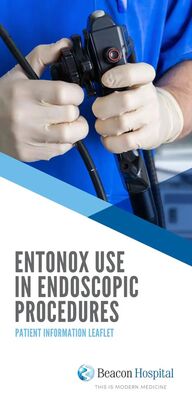
Return to flip book view
Benefits Of Choosing Entonox Breathing Entonox has no lasting effects 30 minutes after you have stopped breathing Entonox you will be able to drive home You can carry on with your normal daily routine and will not require any monitoring or person to look after you ENTONOX USE IN ENDOSCOPIC PROCEDURES Useful sources of information BOC Healthcare ENTONOX medical nitrous oxide and oxygen mixture BOC Healthcare Contact Us If you have any questions or concerns about using Entonox you can call the Endoscopy Department on 01 650 4617 Monday to Friday 9am to 5pm Beacon Hospital Sandyford Dublin 18 D18 AK68 Version 1 7 2021 PATIENT INFORMATION LEAFLET Tel 01 293 6600 www beaconhospital ie THIS IS MODERN MEDICINE
ENTONOX USE IN ENDOSCOPIC PROCEDURES PATIENT INFORMATION LEAFLET What Is Entonox Entonox or Equanox is sometimes referred to as laughing gas or gas and air It has been used since 1965 for relieving pain and anxiety Entonox is a 50 50 mixture of nitrous oxide and oxygen gas and is commonly used in childbirth and by the ambulance service for the relief of pain Entonox works very quickly and its effects are felt almost immediately after inhalation It provides very good pain relief and has a relaxing effect without losing consciousness or control Entonox can be used as an alternative to intravenous sedation and pain relief for endoscopic procedures examining the bowel such as colonoscopy and flexible sigmoidoscopy It cannot be used in procedures examining the stomach as it requires inhalation through a mouthpiece Benefits Of Entonox Entonox is self administered via a patient controlled on demand mouthpiece therefore the patient is in full control of their pain relief requirements The effects of the Entonox gas will be felt after approximately six to eight inhalations After inhalation has stopped the gas and its effects wear off within eight minutes For this reason you will not need anyone to look after you for twelve hours afterwards a necessity after receiving injections of painkiller and sedative drugs for an endoscopic examination Our policy is to monitor you for 30 minutes before you are discharged You can drive again at this time After receiving injections of painkiller sedative drugs a patient cannot drive for twenty four hours How Do I Use Entonox What Happens When I Stop Using Entonox Following your admission you will be shown the mouthpiece and instructed on how to breathe the Entonox gas in and out After the procedure the Entonox mouthpiece will be taken from you The effects of this gas will take about eight minutes to leave the body When the Consultant is ready to start your procedure the nurse will tell you to start breathing in the Entonox gas You will breath the Entonox gas for two to eight breaths before your procedure commences This will give the Entonox time to take full effect and for you to feel comfortable using the gas You can continue to breathe the Entonox throughout your procedure Please breath as normal throughout Are There Any Risks If you find the Entonox gas is unsatisfactory the endoscopist will assess you and offer an alternative Warning Where the alternative offered is an injection of painkillers or a sedative you will need a responsible adult to collect you You will need to be supervised for 24 hours and cannot drive operate machinery or sign legal documents during this time There are no serious risks and very few side effects from inhaling Entonox gas Occasionally you may feel some light headedness some tingling in the fingers and face and a little sickness or dizziness This usually happens if you are breathing the gas in and out too quickly This is called hyperventilating If this does occur the nurse will tell you to slow down your breathing to a normal rate and the side effects will stop Entonox is not always suitable for everyone and there are conditions illnesses where Entonox gas cannot be used These are Ear disorders or previous ear or eye surgeries Facial Injury Drunk or intoxicated patients Patients with head injuries Within 72 hours of diving using oxygen tanks Patients who have previously suffered the bends from deep sea diving Patients who are heavily sedated or unconscious Severe bad COPD asthma oxygen levels which are normally below 94 Previous chest injuries Any kind of previous pneumothorax air in between the lung membranes During the first 16 weeks of pregnancy Patients with laryngectomy throat surgery A full assessment of your suitability for Entonox will be carried out upon admission